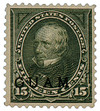
# G10 - 1899 15c Guam - olive green, black overprint
Guam Stamps –
Scarce and Historic
Guam is located to the south of the Mariana Islands and to the east of the Philippines. It is a tiny country of only 212 square miles, and a population of 120,000. About 1/6 of the people of Guam are members of the U.S. military and their families. The native inhabitants of the island are known as Chamorros, who also settled throughout the Philippines. The rest of Guam’s citizens are of mixed descent. In 1521, the Spanish explorer Ferdinand Magellan led the first European expedition to Guam. Spain claimed Guam as its colony shortly thereafter. It was not until 1668, however, that Spain actually took control of Guam.
On April 21, 1898, America declared war on Spain. The media had an instrumental role in this occurrence by printing exaggerated accounts of Spanish oppression. Americans felt that Spain was treating its citizens in the colonies unfairly. The main issue of the Spanish-American war was Cuban independence from Spain. With no strong opposition from Spain, the U.S. was able to win easily.
The Treaty of Paris was signed December 10, 1898. In this treaty resulting from the war, Spain ceded Guam, Puerto Rico, and the Philippines to the United States. The peace treaty was passed by only one vote, due to anti-imperialist attitudes prevalent in America at that time.
Upon its succession to the states, the island of Guam, as well as its postal system, were placed under the supervision of the U.S. Navy Department. The stamps in use in the U.S. at the time were printed by the Bureau of Engraving and Printing. Hence the name of the series of stamps was called the “Bureau Issues.” The stamps used to transport mail from Guam were the same as the Bureau Issues, except for the overprint.
All of the black overprints were applied to the stamps in the U.S., while the red overprints were done at the post office in Guam. The overprints were sold for exactly double the face value currently on the U.S. stamps. Collectors in the U.S. who tried to obtain stamps with the Guam overprint were discouraged by the U.S. Navy Department, making these issues scarce.
On March 29, 1901, a U.S. postal department agent was dispatched to the island to take control of the post office there. On that date, stamps with the Guam overprint ceased to be used. Regular U.S. postage was used from that point on.
Guam Stamps –
Scarce and Historic
Guam is located to the south of the Mariana Islands and to the east of the Philippines. It is a tiny country of only 212 square miles, and a population of 120,000. About 1/6 of the people of Guam are members of the U.S. military and their families. The native inhabitants of the island are known as Chamorros, who also settled throughout the Philippines. The rest of Guam’s citizens are of mixed descent. In 1521, the Spanish explorer Ferdinand Magellan led the first European expedition to Guam. Spain claimed Guam as its colony shortly thereafter. It was not until 1668, however, that Spain actually took control of Guam.
On April 21, 1898, America declared war on Spain. The media had an instrumental role in this occurrence by printing exaggerated accounts of Spanish oppression. Americans felt that Spain was treating its citizens in the colonies unfairly. The main issue of the Spanish-American war was Cuban independence from Spain. With no strong opposition from Spain, the U.S. was able to win easily.
The Treaty of Paris was signed December 10, 1898. In this treaty resulting from the war, Spain ceded Guam, Puerto Rico, and the Philippines to the United States. The peace treaty was passed by only one vote, due to anti-imperialist attitudes prevalent in America at that time.
Upon its succession to the states, the island of Guam, as well as its postal system, were placed under the supervision of the U.S. Navy Department. The stamps in use in the U.S. at the time were printed by the Bureau of Engraving and Printing. Hence the name of the series of stamps was called the “Bureau Issues.” The stamps used to transport mail from Guam were the same as the Bureau Issues, except for the overprint.
All of the black overprints were applied to the stamps in the U.S., while the red overprints were done at the post office in Guam. The overprints were sold for exactly double the face value currently on the U.S. stamps. Collectors in the U.S. who tried to obtain stamps with the Guam overprint were discouraged by the U.S. Navy Department, making these issues scarce.
On March 29, 1901, a U.S. postal department agent was dispatched to the island to take control of the post office there. On that date, stamps with the Guam overprint ceased to be used. Regular U.S. postage was used from that point on.












